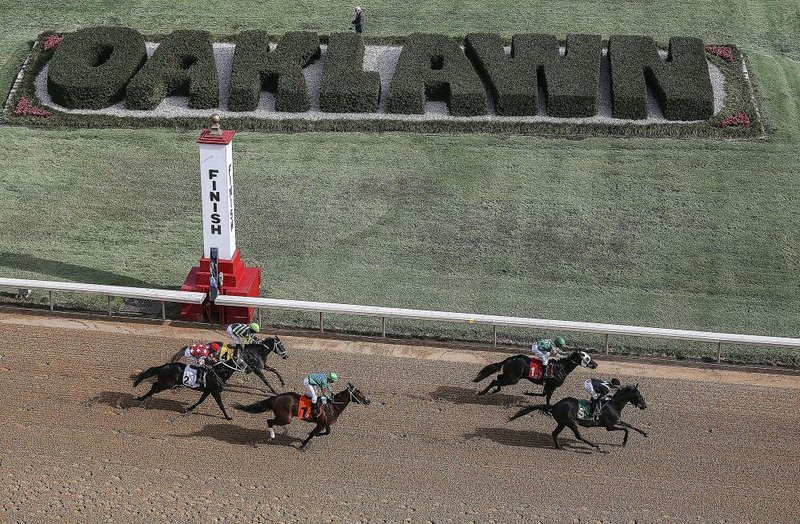HOT SPRINGS -- The role of Lasix at racetracks across the country will soon face its most significant challenge.
Oaklawn Park is among a coalition of United States racetracks and horse racing organizations to have announced an incremental plan to ban the use of the anti-bleeding medication furosemide, commonly known as Lasix, under two specific circumstances beginning in 2020.
The measures announced April 18 will not have a direct effect on racing at Oaklawn until 2021, but track horsemen, management, and ownership have expressed a mixture of concern and interest in the short- and long-term results of the effort. A ban on race-day use of Lasix for 2-year-old horses will begin in 2020. Oaklawn does not have races for 2-year-olds, but the race-day ban extends to all stakes races in 2021, which includes all Triple Crown races and Kentucky Derby preps.
"The general premise is that, I think, everyone would like to see medication-free racing," Oaklawn President Louis Cella said. "Now, that's going to be very difficult to do, but I think everyone would like to see that."
Oaklawn will join racetracks owned and operated by Churchill Downs Incorporated, the New York Racing Association, and the Stronach Group, as well as other independent tracks including Del Mar in San Diego, Keeneland in Lexington, Ky., Lone Star Park in Dallas, Los Alamitos in Cypress, Calif., Remington Park in Oklahoma City and Tampa Bay Downs.
Lasix is a diuretic that reduces blood volume, an effect connected to the possibility of reduced blood pressure and a consequential reduction of exercise-induced pulmonary hemorrhages, or bleeding in the lungs. Lasix is commonly used as a preventative measure regardless of a racehorse's experience with bleeding under the stress of extreme physical exertion. Of the 90 horses entered for Oaklawn's nine-race card today, 89 are listed to run on intravenous injections of Lasix, a figure somewhat in line with the approximately 95 percent of horses given Lasix before races at U.S. tracks.
"I doubt if every one of those horses are bleeders," Cella said. "Something needs to be done, and I think this is the first step for discussion purposes."
Some trainers are concerned a ban on Lasix might limit the pool of horses eligible for racing.
"It's not going to happen overnight, but long term, I think it's going to affect the horse population," said Oaklawn trainer Robertino Diodoro, ranked second at the track with 41 wins. "You're going to see more horses having to be retired. They might be perfectly sound leg-wise, but if they have bad lungs, and they can't run on Lasix, there's going to be an issue there."
"My concern is that it's very likely to make a shorter horse population than we already have," said Norm McKnight, whose 26 wins rank fourth among Oaklawn trainers this season. "Every jurisdiction seems to be struggling with enough horses to put on proper cards, and I think you're going to lose a certain percentage of them with the removal of Lasix."
Among thoroughbred racing organizations worldwide, only those in the U.S. allow the use of Lasix. In part, organizers of steps underway to reduce or eliminate its use at U.S. racetracks say their attempts are aimed at meeting current international standards, even if it limits racing opportunities.
"In most jurisdictions outside of the United States, they do not race nearly as often as they do here," Cella said. "Maybe that has something to do with it. Maybe we need to curtail racing dates. I mean, who knows? But that is something that has become an open discussion, because at these other jurisdictions that do not permit Lasix, they do not race nearly as often, and they don't have circuits that are year-round for racing. In America, you can race somewhere every day of the year."
News of fatal horse injuries at Santa Anita Park has drawn attention to the danger present at all racetracks. From late December through mid-March, 23 horses were euthanized at the track as a result of injuries from racing or training at Santa Anita in southern California. Whereas there is no known connection between Lasix and life-threatening injuries, some feel the move toward a ban on the use of Lasix in racing was at least in part a reaction to the recent trouble at Santa Anita.
"That's a cop out because it's not Lasix that's causing the horses to breakdown," McKnight said. "One has nothing to do with the other. It makes no sense to me, the whole thing. We have a problem at Santa Anita so now we're just going to ban all the drugs."
Oaklawn director of racing Jed Doro said the Lasix ban was the first step in a long-term effort to preserve the well-being of horses and the industry. He said it displayed a unity among tracks and racing organizations toward that end.
"For us, we're for integrity," Doro said. "We're for all the right safety measures, and this is a step in a direction of showing a coalition of almost everybody."
Louis Cella said his late father Charles Cella had pursued avenues toward drug-free racing during his long tenure as the owner and president of Oaklawn.
"In the '70s, my father campaigned against all medication," Cella said. "Back in the '70s, you could see medication creep into racing. He was the strongest advocate against any of that. Well, he lost that argument, and here we are, 50 years later, and every horse on the card is running on Lasix."
Cella said the Lasix bans over the next two years of racing were the first steps toward his father's goals and that he was unsure where they would lead. Regardless of the long-term results, McKnight said horsemen will adapt to the changes.
"Everybody will adjust, and things will happen," McKnight said. "Life will carry on."
Sports on 04/26/2019
